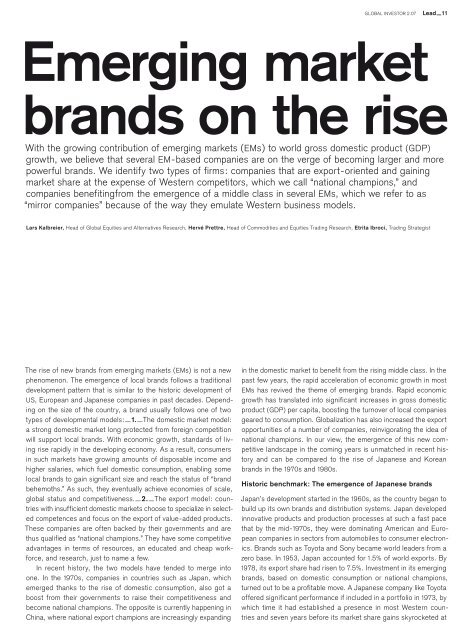You also want an ePaper? Increase the reach of your titles
YUMPU automatically turns print PDFs into web optimized ePapers that Google loves.
GLOBAL INVESTOR 2.07 Lead — 11<br />
Emerging market<br />
brands on the rise<br />
With the growing contribution of emerging markets (EMs) to world gross domestic product (GDP)<br />
growth, we believe that several EM-based companies are on the verge of becoming larger and more<br />
powerful brands. We identify two types of firms: companies that are export-oriented and gaining<br />
market share at the expense of Western competitors, which we call “national champions,” and<br />
companies benefitingfrom the emergence of a middle class in several EMs, which we refer to as<br />
“mirror companies” because of the way they emulate Western business models.<br />
Lars Kalbreier, Head of Global Equities and Alternatives Research, Hervé Prettre, Head of Commodities and Equities Trading Research, Etrita Ibroci, Trading Strategist<br />
The rise of new brands from emerging markets (EMs) is not a new<br />
phenomenon. The emergence of local brands follows a traditional<br />
development pattern that is similar to the historic development of<br />
US, European and Japanese companies in past decades. Depending<br />
on the size of the country, a brand usually follows one of two<br />
types of developmental models:—1.—The domestic market model:<br />
a strong domestic market long protected from foreign competition<br />
will support local brands. With economic growth, standards of living<br />
rise rapidly in the developing economy. As a result, consumers<br />
in such markets have growing amounts of disposable income and<br />
higher salaries, which fuel domestic consumption, enabling some<br />
local brands to gain significant size and reach the status of “brand<br />
behemoths.” As such, they eventually achieve economies of scale,<br />
<strong>global</strong> status and competitiveness.—2.—The export model: countries<br />
with insufficient domestic markets choose to specialize in selected<br />
competences and focus on the export of <strong>value</strong>-added products.<br />
These companies are often backed by their governments and are<br />
thus qualified as “national champions.” They have some competitive<br />
advantages in terms of resources, an educated and cheap workforce,<br />
and research, just to name a few.<br />
In recent history, the two models have tended to merge into<br />
one. In the 1970s, companies in countries such as Japan, which<br />
emerged thanks to the rise of domestic consumption, also got a<br />
boost from their governments to raise their competitiveness and<br />
become national champions. The opposite is currently happening in<br />
China, where national export champions are increasingly expanding<br />
in the domestic market to benefit from the rising middle class. In the<br />
past few years, the rapid acceleration of economic growth in most<br />
EMs has revived the theme of emerging brands. Rapid economic<br />
growth has translated into significant increases in gross domestic<br />
product (GDP) per capita, boosting the turnover of local companies<br />
geared to consumption. Globalization has also increased the export<br />
opportunities of a number of companies, reinvigorating the idea of<br />
national champions. In our view, the emergence of this new competitive<br />
landscape in the coming years is unmatched in recent history<br />
and can be compared to the rise of Japanese and Korean<br />
brands in the 1970s and 1980s.<br />
Historic benchmark: The emergence of Japanese brands<br />
Japan’s development started in the 1960s, as the country began to<br />
build up its own brands and distribution systems. Japan developed<br />
innovative products and production processes at such a fast pace<br />
that by the mid-1970s, they were dominating American and European<br />
companies in sectors from automobiles to consumer electronics.<br />
Brands such as Toyota and Sony became world leaders from a<br />
zero base. In 1953, Japan accounted for 1.5% of world exports. By<br />
1978, its export share had risen to 7.5%. Investment in its emerging<br />
brands, based on domestic consumption or national champions,<br />
turned out to be a profitable move. A Japanese company like Toyota<br />
offered significant performance if included in a portfolio in 1973, by<br />
which time it had established a presence in most Western countries<br />
and seven years before its market share gains skyrocketed at

















